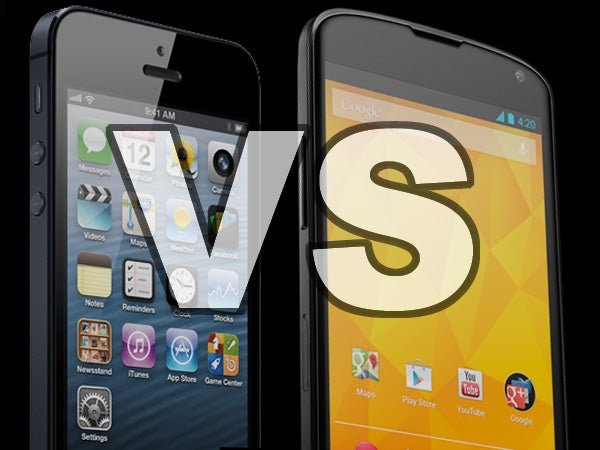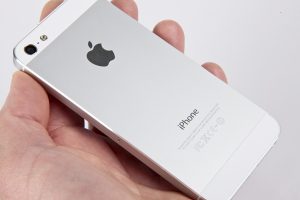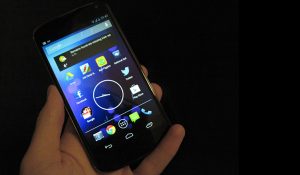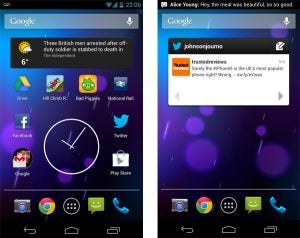Google Nexus 4 vs iPhone 5

The Google Nexus 4 is one of the most desirable Android phones of the year. Make that one of the most desirable gadgets of the year, full stop. But can it really lure us away from the prospect of shiny new iPhone 5?
We took a look at the design, specs, screens, value and power of both phones to see where each comes out on top. Read on for the full verdict.
Read our Google Nexus 4 vs Samsung Galaxy S3 comparison >
Design
Google Nexus 4 – glass rear, plastic main body, disco ball rear finish
iPhone 5 – aluminium body, slate or white finish
For the past two generations of the iPhone, the design of the phone relied on glass sheets covering both the front and back. It looked and felt great, but wasn’t necessarily all that practical – glass smashes on impact. A crack-ridden iPhone 4S is a common sight.
This, we imagine, is part of the reason Apple switched the glass rear for aluminium in the iPhone 5. Its front is still toughened glass, but the back is shatter-proof. Another benefit of using aluminium is that it’s extremely light. The iPhone 5 is just 112g, more than 25g lighter than the Google Nexus 4. 
The first impression the iPhone 5 leaves is one of being almost unnervingly light, and it’ll take some getting used to if you’re a previous iPhone 4S or iPhone 4 owner.
Almost the reverse of the iPhone series’s design trajectory, the Google Nexus 4 features a glass rear. Most of LG’s previous Android phones (LG made the Google Nexus 4) feature plastic bodies.

The glass rear affords the Google Nexus 4 a swanky look, but the iPhone 5 takes the design trophy. For one, the Nexus 4 doesn’t have the ultra-high-end feel of previous iPhones, possibly because the rest of the body is made of plastic rather than metal. Some might consider the rear design a bit over the top too.
Although in real life it doesn’t look anywhere near as garish as it does in pictures, the back of the phone has a disco ball-like finish that isn’t exactly super-classy.
The designs of these two phones tend to reflect their respective prices – the iPhone 5 is a cut above.

Screen
Google Nexus 4 – 4.7-inch 768 x 1,280 pixel IPS screen
iPhone 5 – 4-inch 640 x 1,136 pixel IPS screen
The screens of the Google Nexus 4 and iPhone 5 both use IPS-type screens. This kinda of screen was made most famous in its adoption by iPhones and iPods, and it’s designed to offer great viewing angles – turn the screen and it won’t go dim as some other types do.
The Google Nexus 4 display has a significantly higher pixel count, and much higher screen area – 4.7 inches instead of 4.0. It’s a greater difference than it may sound, especially as the display of the Google Nexus 4 is less widescreen, resulting in a wider display (when the phone’s held “upright”.)
Both these screens are excellent, although more fine tuning has gone into the calibration of the iPhone 5, resulting in technically better images. To be honest, though, you’d have to be quite a display pedant to notice a huge difference.
There’s quite a degree of personal preference here, as to whether you want a pocket-happy phone or are after the largest screen you can get.

Power
Google Nexus 4 – Quad-core 1.5GHz Krait CPU, 2GB RAM
iPhone 5 – Dual-core 1.2GHz Apple A6 CPU, 1GB RAM
The Google Nexus 4 has a pretty impressive processor and RAM combo. It’s one of the first phones to offer 2GB of RAM and uses the quad-core 1.5GHz Krait processor from Qualcomm.
In numbers terms, that sounds a lot better than the dual-core 1.2GHz Apple A6 processor of the iPhone 5, doesn’t it? However, benchmarks show that the numbers don’t always tell the whole truth.
In almost all the most popular benchmarks, the iPhone 5 outperforms the Google Nexus 4, especially in graphical benchmarks. The iPhone 5 has a hugely impressive GPU, the part that handles graphics. This generally excellent performance is down to the architecture of the Apple A6 chip, which was custom-designed by Apple.
Among its Android peers, though, the Google Nexus 4 is a top performer. There won’t be anything you “can’t do” with this phone for quite some time.

Software
Google Nexus 4 – Android 4.2.1, fast updates
iPhone 5 – iOS 6, fast updates
In software terms, the Google nexus 4 is the most “iPhone-like” of all Android phones. It’s not because the version of Android it uses is closer to the iOS software used by iPhones, but rather that it’s an official Google phone. This means it’ll always be among the first phones to get software updates (until discontinued), where others generally have to wait for months, as manufacturers make the necessary tweaks to their (largely unnecessary) custom interfaces.
Whether you’ll prefer iOS or Android is a fairly complex issue. We tend to find the easiest way to discover your likely preference is to ask whether you prefer things to be nice ‘n’ simple, or highly customisable. 
Android 4.2 on the Nexus 4
There’s little you can change in the way iOS works – customisation of an iPhone 5 is limited to changing backgrounds unless you hack the device. Google’s Android is a completely different kettle of cod. You can fiddle with just about everything, and even completely change the system’s graphical front-end, without any technical fiddling. You just need to install an app.
There’s still an element of beautiful simplicity to iOS, although many argue that Apple has left it too late to innovate the system . It has been around since 2007, and hasn’t changed a great deal since then. Android, on the other hand, started as a bit of a mess but has recently upped the ante a good deal, adding much-improved response times to its feature-rich base.



